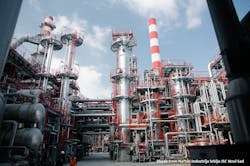Serbia’s NIS breaks ground on delayed coking project
Serbia’s Naftna Industrija Srbije (NIS) JSC Novi Sad has started construction of its long-planned deep conversion, or bottom-of-the barrel (BOTB), complex as part of an ongoing modernization program to improve energy efficiency, boost production of higher-quality products, and ensure operational reliability at its 4.8 million-tonne/year refinery at Pancevo (OGJ Online, Mar. 16, 2015).
A groundbreaking ceremony for the project was held on Oct. 23 in Pancevo, marking the start of a second stage of modernization works planned for the refinery under a broader program initiated in 2009 to optimize overall performance and guarantee long-term competitiveness of the manufacturing site, NIS and majority shareholder JSC Gazprom Neft said in separate releases.
Requiring a total investment of more than €300 million, the BOTB project will include the addition of a delayed coking unit equipped with proprietary process technology from Chevron Lummus Global—a CB&I-Chevron Corp. joint venture—that will be integrated with the refinery’s existing CB&I fluid catalytic cracking and Chevron Lummus Global-licensed hydrocracking units (OGJ Online, Dec. 1, 2016).
NIS previously confirmed the BOTB complex also would house new auxiliary units, including an amine regeneration unit and acid water stripper with a unit for removal of phenol (OGJ Online, Nov. 7, 2016).
Once operational, the 2,000-tonne/day BOTB complex will increase Pancevo’s processing efficiency to 99.2% from a current 86%, as well as increase the refinery’s production of high-quality, low-sulfur gasoline and diesel by more than 38%, NIS and Gazprom Neft said.
Alongside helping improve environmental performance of the refinery by enabling it to cease production of high-sulfur, heavy fuel oil, startup of the new complex will allow Pancevo to begin domestic production of petcoke, a product that, to date, Serbia has been forced to import.
Construction of the project—for which CB&I is providing engineering, procurement, and construction management services—is scheduled to be completed in third-quarter 2019, NIS said.
Modernization program
Last year, NIS completed a €7-million turnaround involving planned maintenance and upgrading projects at nearly all of Pancevo’s primary and secondary processing units, including upgrades to the crude atmospheric and vacuum distillation and hydrogen units, as well as the first capital maintenance at the refinery’s mild hydrocracking and distillate hydrotreating complex since its startup in November 2012 to enable production of Euro 5-standard fuels (OGJ Online, Aug. 25, 2014).
The September 2016 turnaround followed a series of additional projects executed at the refinery earlier that year involving the bitumen production unit, the small atmospheric distillation unit (S-100), and the kerosene Merox unit (S-750/850).
This year, NIS completed a nearly €10-million project to install a digital in-line fuel blending system to control the entire blending process across 12 pipelines and multiple pumps supplying fuel components for precise blending into finished products that conform to Euro 5-quality specifications, as well as projects to reduce sulfur emissions at the site, including revitalization of its S-2450 unit for sulfur extraction from oil and reliability improvement of the S-2600 unit.
Including the more-than €540-million first-phase and current second-phase modernization works, total investments since 2009 into further developing and improving operational performance of the Pancevo refinery have exceeded €2.5 billion, said Alexander Dyukov, chairman of Gazprom Neft’s management board.
Jointly owned by JSC Gazprom Neft, 56.15%; the Republic of Serbia, 29.87%; as well as current and former employees, citizens, and other minor shareholders, 13.98%, NIS also operates the 2.5 million-tpy Novi Sad refinery, which currently remains offline.
Contact Robert Brelsford at [email protected].

